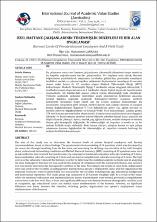| dc.contributor.author | Çankaya, Muhammet | |
| dc.date.accessioned | 2019-04-08T07:09:39Z | |
| dc.date.available | 2019-04-08T07:09:39Z | |
| dc.date.issued | 2017 | |
| dc.identifier.citation | Çankaya, M. (2017). Özel hastane çalışanlarının tükenmişlik düzeyleri ve bir alan uygulaması, International Journal of Academic Value Studies, 3(9), 1-15. | en_US |
| dc.identifier.issn | 2149-8598 | |
| dc.identifier.uri | http://www.javstudies.com/Makaleler/354801754_1-Muhammet%20%C3%87ANKAYA_1-15.pdf | |
| dc.identifier.uri | http://dx.doi.org/10.23929/javs.133 | |
| dc.identifier.uri | https://hdl.handle.net/11491/409 | |
| dc.description.abstract | Bu çalışmanın amacı özel hastane çalışanlarının tükenmişlik düzeylerini tespit etmek ve
bu tespitler doğrultusunda öneriler geliştirmektir. Veri toplama aracı olarak, literatür
bilgilerinden yararlanılarak araştırmacı tarafından geliştirilen; personelin tanımlayıcı
özellikleri, meslek ve çalışma koşulları hakkındaki düşüncelerini tanımlayan 14 sorudan
oluşan anket formu ile 22 sorudan oluşan Maslach Tükenmişlik Ölçeği (MTÖ)
kullanılmıştır. Maslach Tükenmişlik Ölçeği; 9 maddeden oluşan duygusal tükenmişlik, 5
maddeden oluşan duyarsızlaşma ve 8 maddeden oluşan kişisel başarı alt boyutlarından
oluşmaktadır. Alt ölçeklerdeki puanın yüksek olması tükenmişliği ifade etmektedir.
Verilerin analizinde kullanılan istatistiksel analiz yöntemlerini belirlemek amacıyla,
normal dağılıma uygunluk analizinde Kolmogorov-Smirnov sınaması, verilerin
homojenlik durumunu tespit etmek için ise Levene sınaması kullanılmıştır. Bu
sınamaların sonuçlarına göre cinsiyet, medeni durum, eşin çalışma durumu ve çalışılan
kurum değişkenlerinde; Bağımsız T Testi kullanılırken görev, yaş, eğitim durumu ve
mesleki deneyim değişkenlerinde ise Kruskal Wallis Testi kullanılmıştır. Çalışma grubu,
274 özel hastane personelinden oluşmaktadır. Çalışma sonucunda katılımcıların duygusal
tükenme ve duyarsızlaşma puanları normal düzeyde çıkarken kişisel başarı puanları ise
düşük düzeyde çıkmıştır. Ayrıca; meslek, yaş, eğitim durumu, mesleki deneyim ve medeni
durum gibi demografik değişkenler ile tükenmişliğin alt boyutları arasında en az bir
anlamlı farklılık tespit edilmiştir. Buna karşın cinsiyet, çalışılan kurum ve eşin çalışıp
çalışmama durumu değişkenleri ile tükenmişliğin alt boyutları arasında herhangi bir
anlamlı farklılık bulunamamıştır. | en_US |
| dc.description.abstract | The aim of this study was to determine the burnout levels of private hospital employees and develop recommendations based on these findings. The questionnaire form consisting of 14 questions which was developed by the researcher through benefiting from the literature, and describing the defining characteristics of the staff, thoughts about professional and working conditions and Maslach Burnout Inventory (MBI) consisting of 22 questions were used as data collection tool. Maslach Burnout Inventory is composed of emotional exhaustion subscale consisting of 9 items, depersonalization subscale consisting of 5 items and personal accomplishment subscale consisting of 8 items. The high scores on the subscales represent the burnout. In order to determine the statistical analysis methods used in analyzing the data, Kolmogorov-Smirnov test was used for the analysis of compliance with the normal distribution, and Levene's test was used to determine the homogeneity condition of the data. According to the results of these tests, independent t test was used for the variables including gender, marital status, spouse's employment status and the organization the employee works for, while Kruskal Wallis test was used for the variables including task, age, educational background and professional experience. The study group was composed of 274 private hospitals staff. As a result of the study, while the emotional exhaustion and depersonalization scores of participants were normal, personal accomplishment scores were at the low level. Also, at least one significant difference was detected between demographic variables such as occupation, age, educational status and marital status subdimensions of the burnout. However, no significant difference was found between the variables, including gender, organization and spouse's employment status subdimensions of the burnout. | en_US |
| dc.language.iso | tur | en_US |
| dc.publisher | JAVS Studies | en_US |
| dc.relation.isversionof | 10.23929/javs.133 | en_US |
| dc.rights | info:eu-repo/semantics/openAccess | en_US |
| dc.rights.uri | https://creativecommons.org/licenses/by-nc-sa/4.0/ | |
| dc.subject | Tükenmişlik | en_US |
| dc.subject | Sağlık Çalışanları | en_US |
| dc.subject | Hastane | en_US |
| dc.subject | Maslach Tükenmişlik Ölçeği | en_US |
| dc.subject | Burnout | en_US |
| dc.subject | Healthcare Professionals | en_US |
| dc.subject | Hospital | en_US |
| dc.subject | Maslach Burnout Inventory | en_US |
| dc.title | Özel hastane çalışanlarının tükenmişlik düzeyleri ve bir alan uygulaması | en_US |
| dc.title.alternative | Burnout levels of private hospital employees and a field study | en_US |
| dc.type | article | en_US |
| dc.relation.journal | International Journal of Academic Value Studies | en_US |
| dc.department | Hitit Üniversitesi, Sağlık Bilimleri Fakültesi, Sağlık Yönetimi Bölümü | en_US |
| dc.authorid | 0000-0003-3498-7328 | en_US |
| dc.identifier.volume | 3 | en_US |
| dc.identifier.issue | 9 | en_US |
| dc.identifier.startpage | 1 | en_US |
| dc.identifier.endpage | 15 | en_US |
| dc.relation.publicationcategory | Makale - Uluslararası Hakemli Dergi - Kurum Öğretim Elemanı | en_US |



















